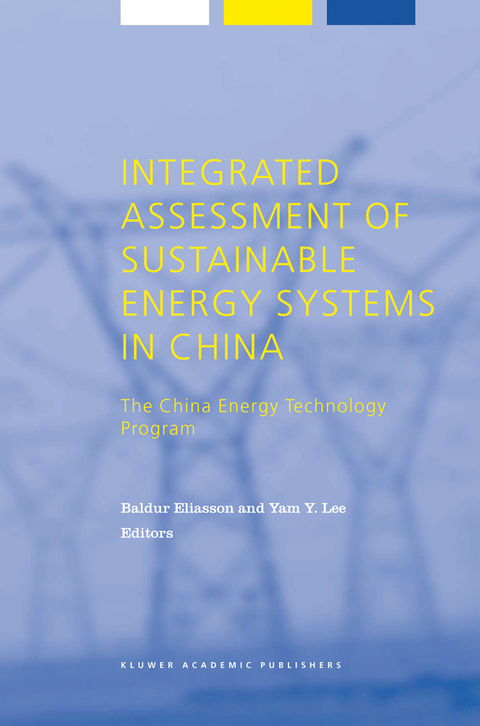
Integrated Assessment of Sustainable Energy Systems in China, The China Energy Technology Program
Springer-Verlag New York Inc.
978-1-4020-1199-3 (ISBN)
1 Introduction.- The Ags/abb Collaboration.- The Cetp Story.- The Cetp Idea.- A Living Program.- The Structure of the Program.- An Idea for the Future.- References.- Notes.- 2 General Description/ Approach and Methodology.- 1. General Description.- 2. Shandong Province.- 3. Operation of Cetp.- 4. Components of the Program.- 5. Conclusion.- References.- 3 Data Collection and Database Development.- 1. the Data Collection Task.- 2. Database Development.- Notes.- 4 Demand Forecasting.- 1. Geographic, Social, and Economic Characteristics.- 2. Shandong’S Energy Profile.- 3. Goals and Methodology.- 4. Scenario Construction.- 5. Important Assumptions in Energy Demand Forecasting.- 6. The Primary Sector.- 7. The Industrial Sector.- 8. Construction.- 9. Transportation.- 10. Services.- 11. Households.- 12. Evolution of Electricity Consumption.- 13. Assumptions Included in Forecasting Electricity Demand in the Additional Scenarios.- 14. Rorecasting Results and Analysis.- 15. Conclusions.- 5 EnergyEconomy Modeling Scenarios for China and Shandong.- 1. Introduction.- 2. General Background About China and Shandong Province.- 3. Energy and Economy Modeling (EEM) Approach.- 4. Model Results: Markal.- 5. CRETM FOR BOTH CHINA AND SHANDONG PROVINCE.- 6. Integration of Results.- 7. Findings, Conclusions, and Recommendations.- References.- Notes.- 6 Electric Sector Simulation: A Tradeoff Analysis of Shandong Province’s Electric Service Options.- 1. Introduction.- 2. Scenario-Based Multi-Attribute Tradeoff Analysis.- 3. Electric Sector Simulation.- 4. Overview of the Ess Scenarios.- 5. Shandong Uncertainties and Futures.- 6. Shandong Options and Strategies.- 7. The Reference Strategy and the Impact of Growth and Fuel Cost Uncertainties.- 8. Performance of Ess Scenarios.- 9. Extending the Range of Options.- 10. Encompassing Greater Uncertainties.- 11. Conclusions.- References.- 7 Energy Transportation Modeling.- 1. Introduction.- 2. Model Description.- 3. Scenario Analysis with ETM.- 4. Concluding Remarks.- References.- 8 Life Cycle Assessment.- 1. Introduction.- 2. The Coal Chain.- 3. The Natural Gas Chain.- 4. the Nuclear Chain.- 5. Wind Power.- 6. Comparison of Current and Future Energy Chains.- 7. Sensitivity Analysis for the Energy Chains.- 8. Analysis of Scenarios Selected for the MCDA Task.- 9. Conclusions.- 10. Outlook.- References.- Notes.- 9 Environmental Impact and External Cost Assessment.- 1. Introduction.- 2. Objectives, Scope and Sub-Tasks.- 3. External Cost Assessment.- 4. Acidification in China and Shandong.- 5. Conclusions.- References.- Notes.- 10 Assessment of Severe Accident Risks.- 1. Introduction.- 2. Objectives and Scope.- 3. Information Sources.- 4. Evaluations for Specific Energy Chains.- 5. Energy Chain Comparisons.- 6. Conclusions.- References.- 11 Multicriteria Output Integration Analysis.- 1. THe Contexts of the Multicriteria Decision Aiding Approach in the Cetp Project.- 2. The Stakeholders Advisory Group (SAG).- 3. The “Potential Actions” or “Decision Scenarios”.- 4. The Criteria.- 5. The Aggregation Method.- 6. The Weighting Process.- 7. The Performance Matrix.- 8. Analysis of the Mcda Results.- References.- Notes.- 12 Comparison and Integration of Cetp Tasks.- 1. Introduction.- 2. Comparison of Electric Sector Methodologies.- 3. DVD Tool for Documentation, Exploration and Decision Support.- 4. Program Management for Integration.- 13 Conclusions and Recommendations.- 1. Introduction.- 2. The Analytic Framework.- 3. Energy and Electricity Demand Forecasting.- 4. Environmental Damage, Health and Accident Risk.- 5. Energy Supply and Use.- 6. Sustainability and Stakeholder Perspectives.- 7. Recommendations.- 8. Overall Remarks and Future Outlook.- Appendix A.- Structure of Cetp.- Appendix B.- Steering Committee.- Stakeholder Advisory Group.- Technical Advisory Board.- Appendix C.- List of Cetp Participants.- Appendix D (Chapter 1).- Task Description.- Appendix E (Chapter 1).- Abb in China.- Appendix F (Chapter 4).- Additional Tables of Data.- Appendix G (Chapter 7).- Mathematical Description of the Model.- Acronyms and Abbreviations.- Units.
| Erscheint lt. Verlag | 30.4.2003 |
|---|---|
| Reihe/Serie | Alliance for Global Sustainability Bookseries ; 4 |
| Zusatzinfo | LVI, 824 p. With online files/update. |
| Verlagsort | New York, NY |
| Sprache | englisch |
| Maße | 160 x 240 mm |
| Themenwelt | Sachbuch/Ratgeber ► Natur / Technik ► Natur / Ökologie |
| Naturwissenschaften ► Biologie ► Ökologie / Naturschutz | |
| Naturwissenschaften ► Geowissenschaften | |
| Technik ► Elektrotechnik / Energietechnik | |
| Technik ► Maschinenbau | |
| Technik ► Umwelttechnik / Biotechnologie | |
| ISBN-10 | 1-4020-1199-7 / 1402011997 |
| ISBN-13 | 978-1-4020-1199-3 / 9781402011993 |
| Zustand | Neuware |
| Haben Sie eine Frage zum Produkt? |
aus dem Bereich


